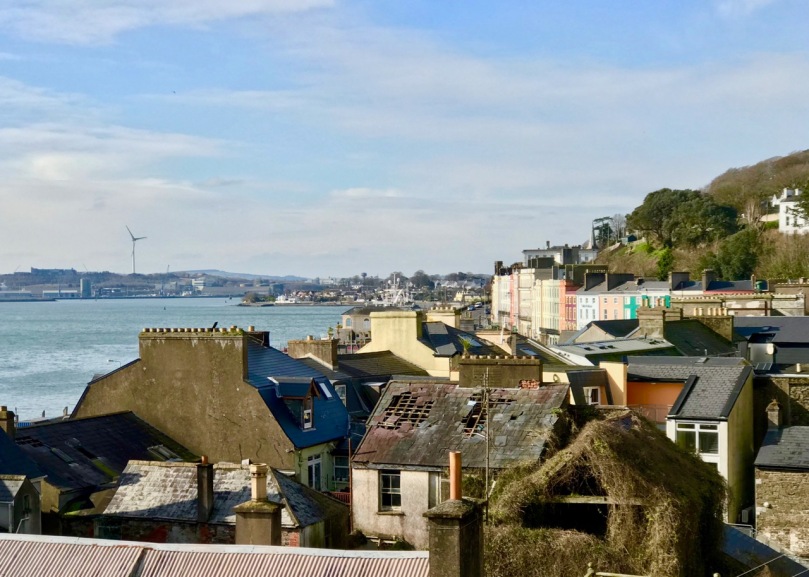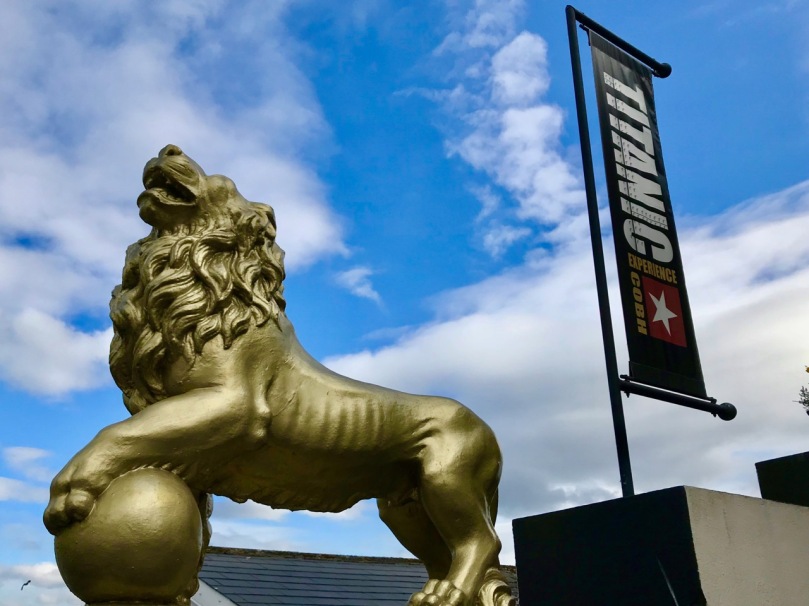My favourite sea voyage was on the (alas now defunct) Swansea to Cork Ferry. I travelled this route very many times while living in Devon and Cornwall, and most enjoyed the last leg of the journey to Ireland, when the ship entered the Lee estuary and made its way upriver to Ringaskiddy. In all weathers I was out on deck to watch the slowly changing scenery that welcomed my arrival in to Cork, knowing that it was surely the best place in all the world to be going!
The excitement mounted when we steamed past the port town of Cobh, as the ferry terminal was then just around the corner. From afar I admired the way this settlement embraced the water with its long, colourful terraces lined up the steep hillside on which it was built, crowned atop by the magnificent Victorian edifice which I now know to be probably the finest architectural work of Edward Welby Pugin in Ireland: St Colman’s Cathedral.
I am almost ashamed to confess, then, that I had never called in on Cobh until last week – and the visit was a relevation. First, let me clear up some possible confusions: the name is pronounced ‘Cove’ – and the word in fact comes from the English, but has been Gaelicised to Cobh, (Irish An Cóbh), the location having allegedly been known since around 1750 as ‘The Cove of Cork’. The name was changed to ‘Queenstown’ after a visit from Queen Victoria in 1849, and was then changed back to Cobh after the founding of the Irish Free State in 1922. Or – have I just contributed to the confusion? One thing is for sure: the strategic waterside location in the great natural harbour of Cork is the raison d’être of this grand town.
Yes, it’s all about the water, and the fact that it is located beside the “second largest natural harbour in the world by navigational area” (a claim also made, incidentally, by Halifax Harbour in Canada and Poole Harbour in the UK – the undisputed nomination for largest harbour is Port Jackson, Sydney, Australia). Cobh faces the wonderfully named Haulbowline Island and Spike Island, both of which have been established as defensive fortifications, and the former as an important naval dockyard since before Napoleonic times. Today, Cobh has the only dedicated cruise ship berth in Ireland.
Do you remember my telling of the story of Cessair and the first human footsteps on Irish soil in our own Bantry Bay? The story is recounted in the 11th century Lebor Gabála Érenn (The Book of the Invasions of Ireland). The same book tells us about Neimheadh and his followers the Muintir Neimhidh – People of Nemed – who arrived soon after Cessair around 2000 BC, but in Cork Harbour and settled the islands there: Neimheadh, like Cessair, shared his genealogy with Noah and is said to be buried in a mound on Great Island, overlooking present-day Cobh.
So why am I so impressed by Cobh? Perhaps it’s because – as an architect – I find the streetscapes so elegant, and quirky. For me it’s a cross between the horizontal graceful manners of Georgian Bath and the higgledy-piggledy uphill habitation of the steep lanes of Newlyn in Cornwall, where I lived for many years.
Above – Cobh yesterday and today, showing the elegance of the development of the town in the nineteenth century. Below – another side of Cobh: the steeply descending streets with some remarkable and picturesque terraces, crowned always by the glory of the Cathedral, which took half a century to build. Construction began in 1867.
Cobh is such an attractive town to walk around: it should be the jewel on County Cork’s tourist trail. This post is a fairly minimalist photographic essay of what caught my eye on the day we visited. There is a lot more to explore: we never made it to the Heritage Centre, nor to the Titanic Experience, which has brought particular fame to the place in recent times: it was the final embarkation point on the ship’s fateful maiden voyage. All for another day. But we did get up to Cobh’s Old Church Cemetery, high on the hill, where the victims of the Lusitania sinking were buried in mass graves in 1915: a poignant place.
But it was the architecture that had me absorbed: well proportioned and detailed buildings – often simple – that may be overlooked except for the way in which they come together into such a dignified whole. And – such an exploration of colour!
There’s much more to tell of the story of Cobh, and – certainly – so much more to see. I will follow up this post in the coming weeks; the magnificent Cathedral can justify an article on its own. Hopefully you will visit yourself if you have not already done so: your eyes will be opened . . . Look out for the small details!



























Hi Robert, I came across this post as I’m doing research for a community development project for college. I’m actually currently sitting in class reading this and as I got to the final picture here I startled the entire class because I was shocked to see my dog Jackson online in a photo that I did not know existed.
Thank you for the post and the beautiful way you spoke of the town that I have fallen in love with over the last 5 years of living here. And thank you for taking an awesome photo of my Jackson.
LikeLiked by 1 person
Seana, it’s good to now put a name to the face! Jackson looks quite the character…
LikeLike
Unfortunately, I have to concede that Cork Harbour is not, after all, the second largest natural harbour in the world. https://passiveimpressions.com/2014/12/15/cork-harbour-the-second-largest-in-the-world/
LikeLike
Great research there – I suppose one should never trust the internet!
LikeLike
Great photos.
After this piece and your interesting article on St Coleman’s I’m planning to visit Cobh. What a colorful place!
I understand that Napoleons Irish doctor ( from St Helena) is buried in the same cemetery that holds the Lusitania victims.
LikeLiked by 1 person
Hi Michael – thank you for the comment: I missed Napoleon’s Irish doctor, so that’s a must to follow up!
LikeLike
Robert – a fantastic picture book story of my town! You caught all the colour………and the history!
Loved your piece on the Fastnet too…….
Keep it up!
Best regards
Eddie English
Cobh
LikeLiked by 1 person
Thank you, Eddie. I was so impressed with the whole character of Cobh. More on this soon. The Fastnet post was Finola’s: an interesting current debate on whether the light should be changed to LED.
LikeLike
Hi Robert, Lindsay and I visited Cobh for the day before our Mizen Head to Malin Head cycle trip began. I had been very interested to see the Old Church Cemetery as I had recently read Dead Wake, a gripping account of the sinking of the Lusitania. Like you we were also charmed by the streetscapes of Cobh as well. We spent a happy few hours in the sunshine there, returning to a downpour in Cork late in the day. A weather pattern we experienced more than once on our wonderful cycle trip north. Thanks for this post!
Cathy
LikeLiked by 1 person
Hello Cathy – good to hear from you. I’m so glad you can still describe your cycle trip from Mizen to Malin as ‘wonderful’ in spite of the appalling weather that was thrown at you! Cobh is a gem…
LikeLike
Thanks for this post Robert. I have a family connection to Cobh and it is a lovely spot. Pleased you visited the Old Church Cemetery. You’ll know that the boxer Jack Doyle also rests there. The older, more run down part of the cemetery is fascinating.
Looking forward to your follow-up posts.
LikeLiked by 1 person
Roy – that’s great that you have those connections. Yes, we did get a look at the old part of the cemetery – some fascinating ancient stones. But the day that was in it ran out, so another visit is called for.
LikeLiked by 1 person